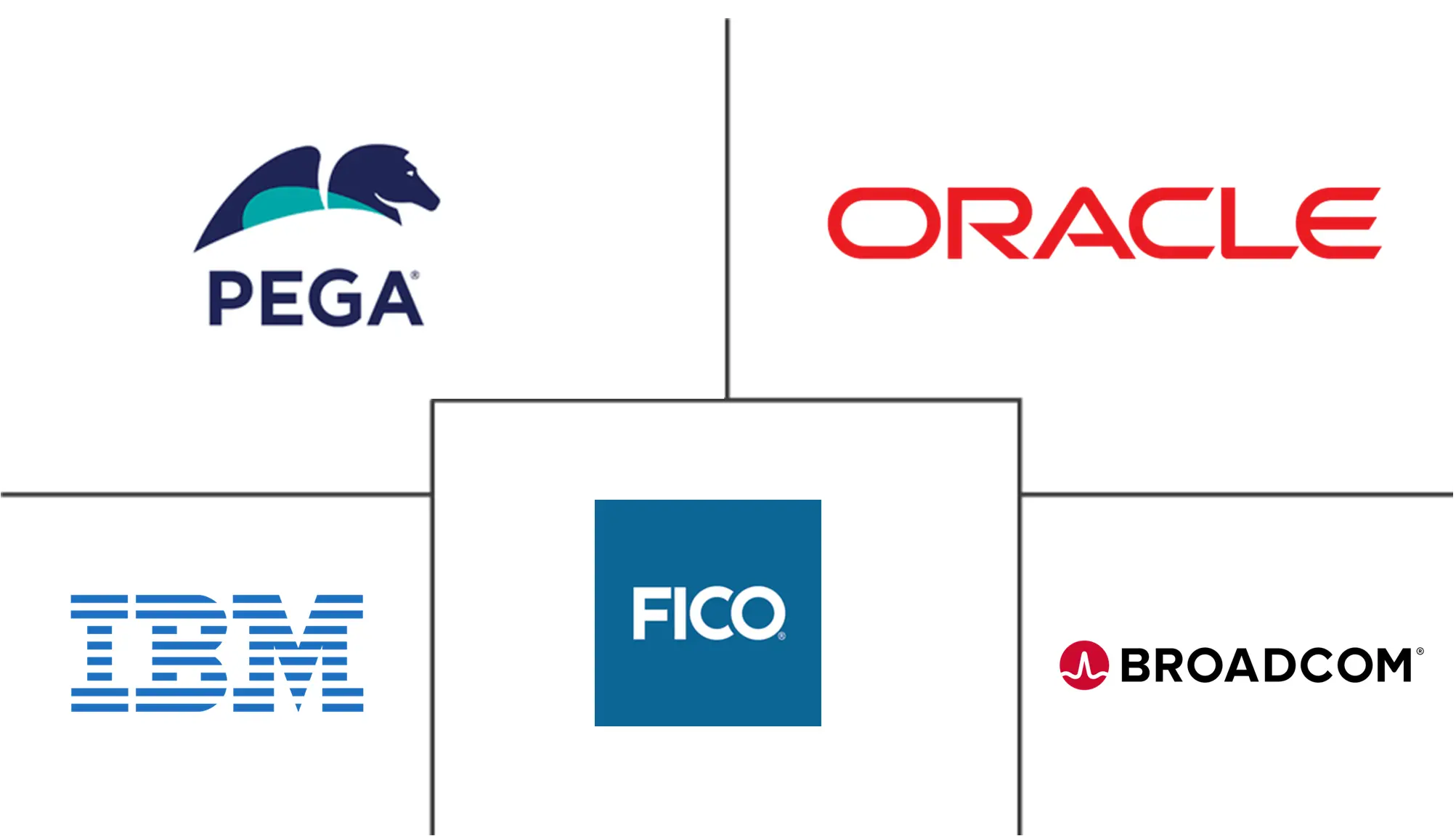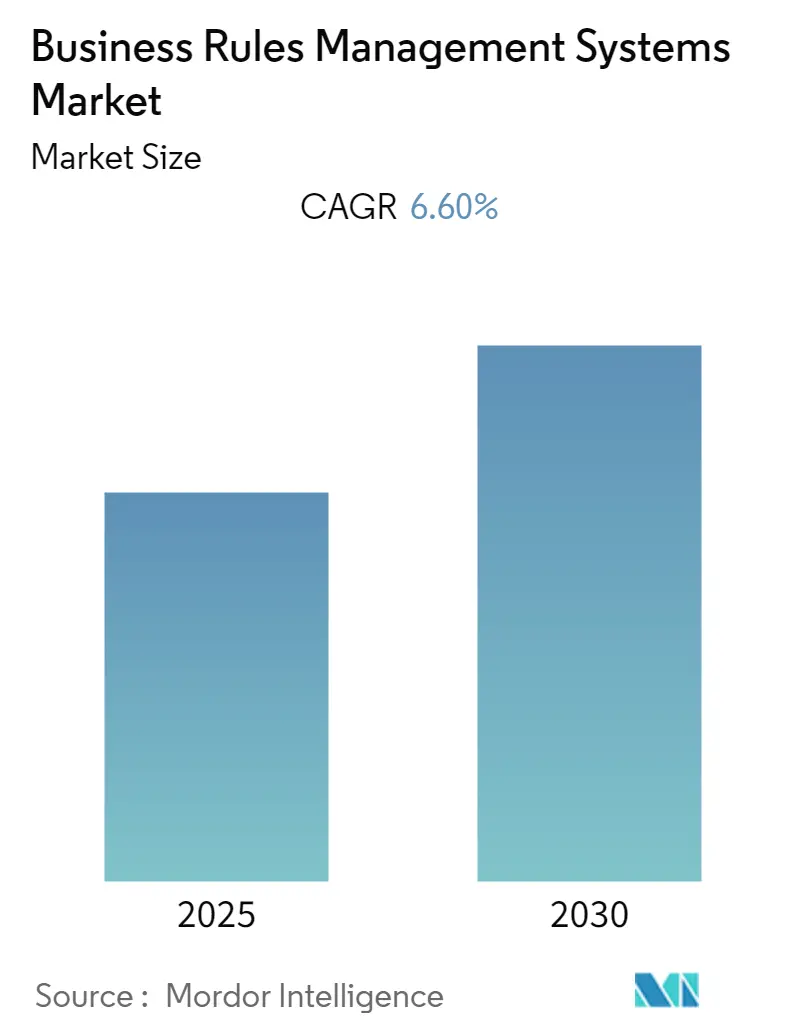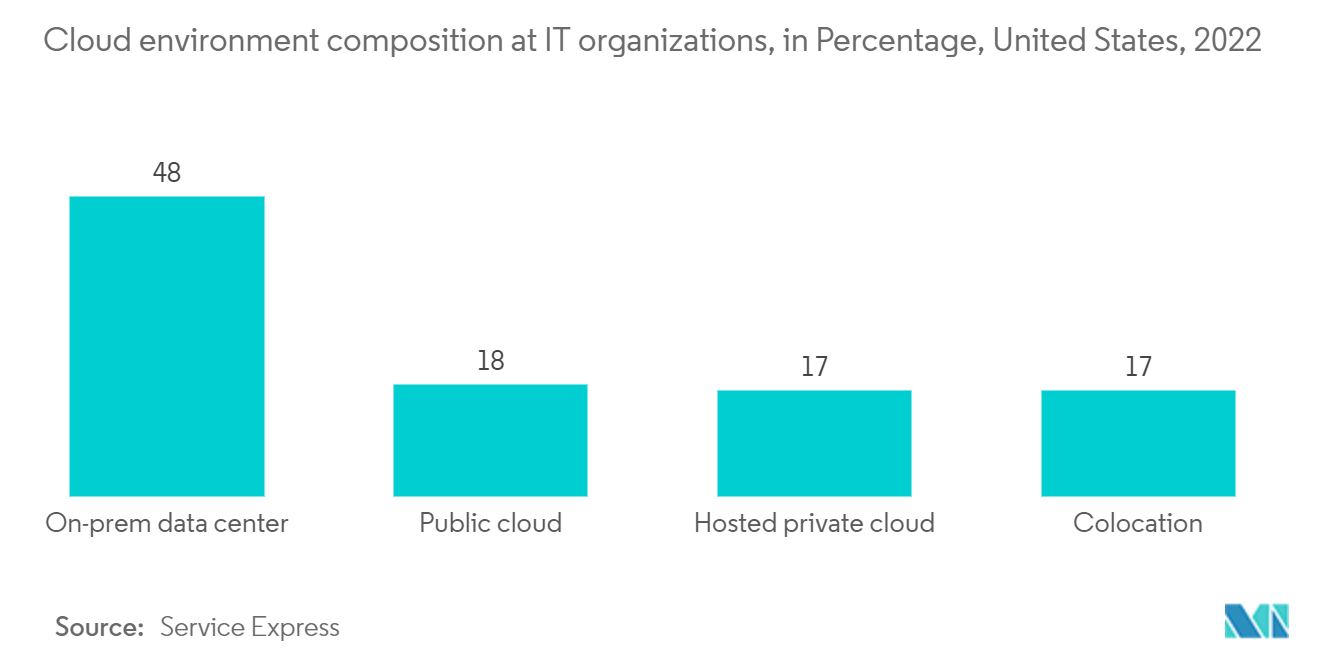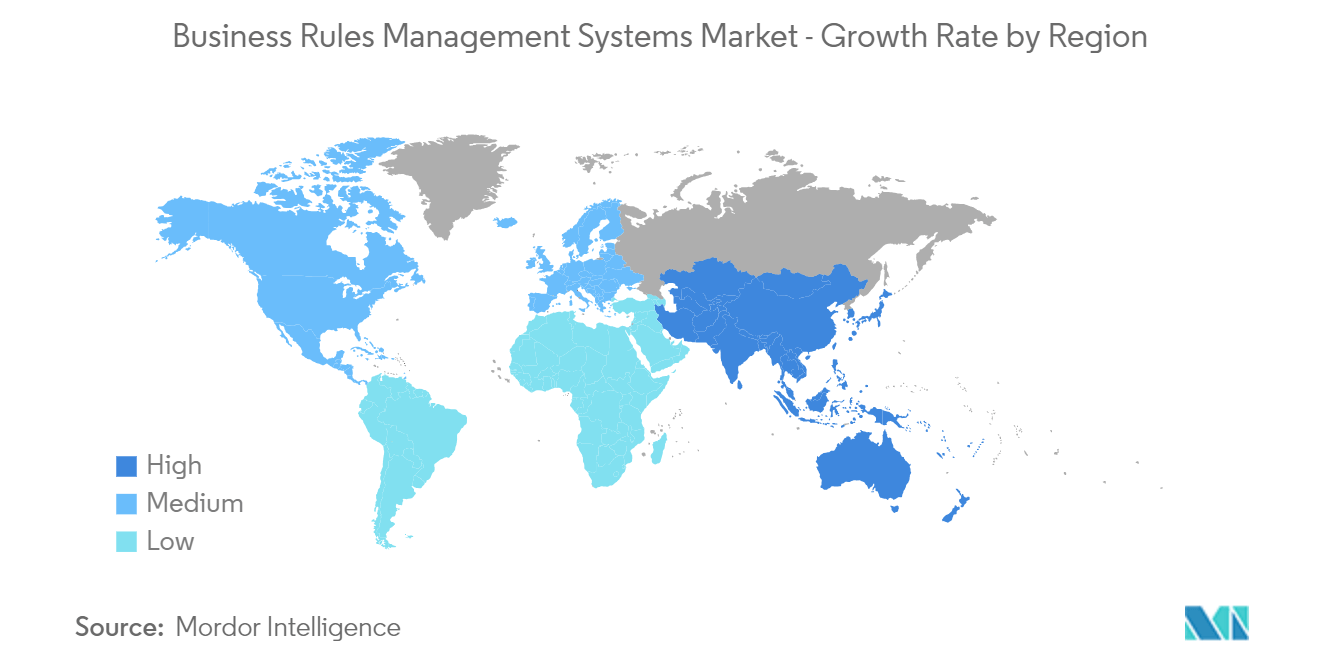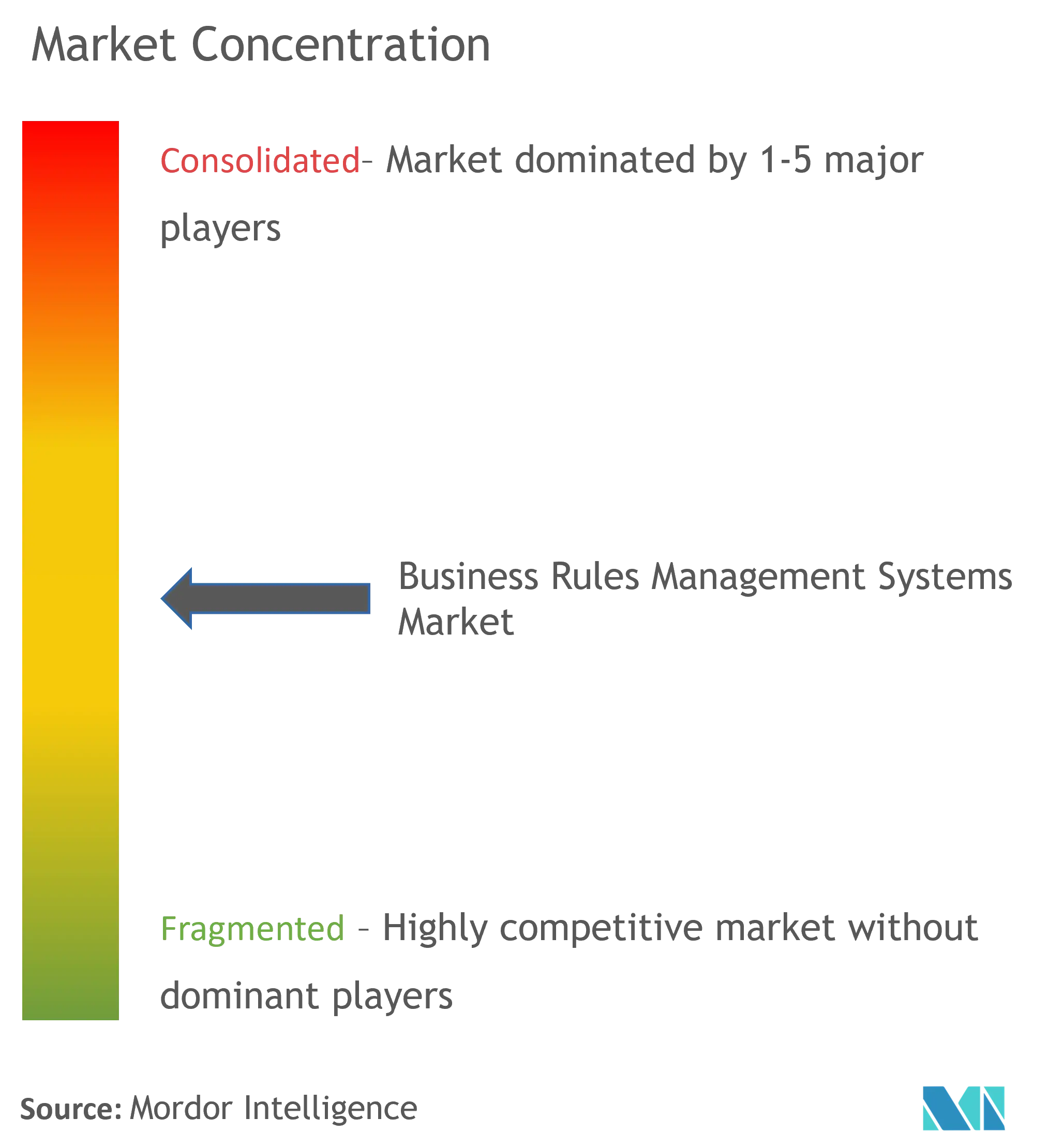Business Rules Management System Market Analysis
The Business Rules Management Systems Market is expected to register a CAGR of 6.6% during the forecast period.
- The profitability of any firm depends on fulfilling deadlines, benchmarks, and targets. However, choosing the most efficient course of action becomes challenging without the proper set of corporate regulations. For suppose, if the company doesn't increase the effectiveness of its processes, it can rapidly lose ground in a market due to its failure to provide in-demand goods and services within a fair amount of time. Therefore, it is crucial to assess current work processes and determine their level of performance regarding important metrics like quality, turnaround time, waste, task redundancy, etc.
- Further, approved non-technical business users can update or modify a BRMS platform as needed, freeing IT to concentrate on higher-value initiatives and development. In addition, IT enterprises can quickly implement changes using a BRMS platform, making it simpler to find and test decision logic as necessary.
- Companies can embrace analytics skills due to their rising focus on gaining a more significant market share and enhancing consumer satisfaction. These analytical capabilities offer substantial advantages, such as timely and pertinent insights into data, for assisting businesses in improving business decisions. Analytics makes it possible to analyze gathered data quickly and affordably to help enterprises better understand their current policies and practices. Additionally, it enables businesses to make wiser selections when rebuilding their policies or altering their operating procedures to satisfy company requirements consistently. The analytical capabilities, such as reporting analytics, predictive analytics, and data mining approaches, assist businesses in gathering data from multiple repositories and gaining insightful knowledge that enables them to match their policies and norms with their ever-evolving business demands.
- However, businesses must regularly update their rules based on evolving business requirements. Due to the urgency of these revisions, it is frequently tricky to properly document business rules, which are commonly overlooked. This could lead to several difficulties businesses encounter when compiling and presenting these rules, as it requires time and effort to identify the sources of business rules. Further, it can be challenging to decipher what rules govern an application when the rules are activated and how they are executed because they are frequently contained in the program coding. These factors could act as a restraining factor for the growth of the studied market.
- Enterprise virtual private network (VPN) servers became a lifeline to companies/schools because of the COVID-19 pandemic, many employees worked from home, and students learned remotely. Therefore, security and availability were crucial factors over the projected period. Due to a lack of preparation, organizations risked having security settings for VPNs configured incorrectly, exposing their devices to DoS attacks, and exposing important data to the internet. Additionally, some users could use personal computers to carry out official tasks, which poses a serious business risk. The need for advancements in secured BRMS will likely offer lucrative opportunities for the market players to innovate efficient products.
Business Rules Management System Market Trends
The Cloud Deployment Segment is Expected to Drive the Market's Growth
- Several industries are shifting their BRMS to cloud deployment to maintain a competitive advantage. For instance, the telecommunications business is undergoing significant transformation. This is due to rapidly evolving technology, growing demand, client base diversification, the need for current products & services at low prices, and the merging of numerous industries, including satellite and cable, with existing telecommunications. Thus, CSPs (cloud service providers) are expected to benefit from implementing enterprise-integrated software by enabling them to achieve logical business process integration across various independent application systems.
- Further, the growing recognition among organizations of the value of saving money and resources by shifting their data to the cloud rather than developing and maintaining new data storage is boosting demand for cloud-based solutions. Cloud platforms and ecosystems are expected to act as a launchpad for an explosion in the pace and size of digital innovation during the next several years.
- According to a service express 2022 poll in the United States, an average of 48% of questioned organizations' IT infrastructure environments were on-premises data centers. The public cloud accounted for 18%, while colocation and hosted private cloud contributed 17%. The cloud deployment segment was projected to witness an upsurge soon as businesses with changing bandwidth demands must be able to scale up and down their capacity quickly. Cloud technology gives businesses the flexibility they need to expand and decrease bandwidth based on the needs of their operations. This strategy can help firms save money while also giving them a competitive advantage.
- Deployment of cloud platforms also allows for the Integration of multiple applications, facilitation of new and extended channels, management of expenses, management of the private cloud, improved access to client data, and improvement of services. For instance, in July 2022, CloudConnect Communications, a B2B virtual network operator (VNO), was licensed by the Department of Telecommunications (DoT) to operate in Mumbai and Ahmedabad. CloudConnect would deliver corporate call management systems with Integrated Cloud-based Communication Solutions, CRM (customer relationship management) Integration with telephony through programmable APIs, and calls and administrative access to the forum in both local and foreign markets.
- In January 2022, Oracle introduced Oracle Cloud for Telcos. Oracle Cloud for Telcos is a complete suite of cloud solutions built on Oracle Cloud Infrastructure. OCI is a cloud platform that can be utilized in dispersed cloud architecture and has 36 public cloud regions globally. Moreover, with over 60 industry application suites, the OCI platform enables third-party, custom, and Oracle Fusion Cloud Applications Suite workloads. Such advancements are anticipated to expand the adoption of BRMS.
North America is Expected to Hold a Major Market Share
- North America is one of the most prominent business rules management systems market regions. North American companies are rapidly evolving their IT infrastructure, leading to the adoption of several technologies required to reduce costs and improve productivity.
- With the speedy acceleration of modern technology and the need for streamlined IT functions, an increasing number of businesses in the region are finding it best to keep pace with the help of modern technologies integrated into the IT infrastructure. Benefits like improved agility and flexibility and deploying new applications more quickly hold significance.
- The firms in the region are adopting BRMS solutions to better serve their customers. For example, the PNC Financial Services Group automated its loan application process using a BRMS to set rules determining whether an application was approved or denied. Further, a business rules management system was set in place by Brownells Inc. to automate compliance as an online retailer operating in a highly regulated sector. The business makes sure customers can only buy things offered in their region by employing a system of restrictions depending on a customer's location.
- Despite supply headwinds, an uncertain economic environment, and labor shortages, the manufacturing industry continues to witness an upsurge in the region. For instance, the gross output of the manufacturing industry in the United States increased from USD 5,501.2 billion in 2020 to USD 6,318.7 billion in 2021. Such an increase in manufacturing activities in the United States is anticipated to boost the growth of the studied market.
- Several investments in the manufacturing sector are also anticipated to offer lucrative opportunities for the growth of the studied market in the region. For instance, in August 2022, US President Joe Biden signed a law committing USD 280 billion to high-tech manufacturing and scientific research. The investments include tax breaks for companies that construct computer chip manufacturing plants in the US.
- Further, in April 2023, US conglomerate Cummins invested over USD 1 billion across its engine manufacturing network in Indiana, North Carolina, and New York. The announcement includes Cummins' plans to invest USD 452 million in its Jamestown Engine Plant to upgrade its 998,000-square-foot facility in Western New York.
Business Rules Management System Industry Overview
The market for business rule management systems is a moderately fragmented market with the presence of many established international players like IBM Corporation, Oracle Corporation, Robert Bosch, etc., operating in the global market. Additionally, these companies are competing with less or no product differentiation. Hence, these companies are actively looking forward to making alliances & acquisitions, and product innovations to gain more market share.
In October 2022, Oracle unveiled a slew of new product developments across its broad portfolio of data and analytics products. Decision-makers now have a prebuilt library of more than 2,000 best-practice KPIs, dashboards, and reports to monitor performance against strategic goals, thanks to new capabilities in Oracle Fusion Analytics spanning CX, ERP, HCM, and SCM analytics. The recent Oracle Analytics Cloud (OAC) improvements were intended to increase business users' productivity by reducing their dependency on IT while benefiting from curated data assets developed by IT, such as the centralized semantic model.
In October 2022, Micro Focus announced an integration of its mainframe application modernization solution with Google Cloud's Dual Run product. Dual Run, announced at Google Cloud Next, uses Micro Focus production platform technology to accelerate, automate, and minimize the risk of migrating mainframe applications to Google Cloud.
Business Rules Management System Market Leaders
-
IBM Corporation
-
Pegasystems Inc.
-
FICO Inc,
-
Oracle Corporation
-
Broadcomm Inc.
- *Disclaimer: Major Players sorted in no particular order
Business Rules Management System Market News
- February 2023: Pegasystems Inc., the low-code platform provider certifying the world's enterprises to build for change, announced that Shawbrook Bank, a UK-based specialist savings and lending bank, deployed the PegaPlatform to transform its unsecured loans process, reducing processing time by 75%, saving 1500 hours per month, and improving customer experience. Labbused the PegaExpress approach, which allowed Shawbrook to quickly generate and capture new requirements and prioritize and reprioritize requirements depending on the business and user feedback.
- October 2022: On its Intellisysplatform, EvolveWare introduced its first Agile Business Rules Extraction (Agile BRE) solution. Through intelligent automation, Agile BRE enabled enterprises to update business policies and modernize applications simultaneously without the inconvenience of freezing code. Enterprises and government agencies can now modify existing code at any point during the rules extraction process with minimal impact on previously completed work. Agile BRE was expected to not only allow enterprises to expedite modernization projects while saving 60+% in time and effort over a manual approach.
Business Rules Management System Industry Segmentation
A business rules management system (BRMS) enables businesses to independently create and manage business logic from applications and processes. Instead of embedding rules as code within multiple applications, a BRMS helps externally manage the rules, away from the application code. By using automated business rules, organizations can specify decision logic in simple terms, close to natural language.
The Business Rules Management System Market is segmented by Offering (Software, Service), Deployment Mode (Cloud, On-Premise), Organization Size (Small and Medium Enterprises, Large Enterprises), End-user Vertical (BFSI, Telecommunication and IT, Retail, Manufacturing, Healthcare), and Geography (North America, Europe, Asia-Pacific, Latin America, Middle East & Africa). The market sizes and forecasts are provided in terms of value (USD) for all the above segments.
| By Offerings | Software |
| Services | |
| By Organization Size | Small and Medium Enterprizes |
| Large Enterprises | |
| By Deployment Type | Cloud |
| On-Premise | |
| By End-user Vertical | BFSI |
| Telecommunication and IT | |
| Retail | |
| Manufacturing | |
| Healthcare | |
| Other End-user Verticals | |
| By Geography | North America |
| Europe | |
| Asia-Pacific | |
| Latin America | |
| Middle East and Africa |
Business Rules Management System Market Research FAQs
What is the current Business Rules Management Systems Market size?
The Business Rules Management Systems Market is projected to register a CAGR of 6.6% during the forecast period (2025-2030)
Who are the key players in Business Rules Management Systems Market?
IBM Corporation, Pegasystems Inc., FICO Inc,, Oracle Corporation and Broadcomm Inc. are the major companies operating in the Business Rules Management Systems Market.
Which is the fastest growing region in Business Rules Management Systems Market?
Asia Pacific is estimated to grow at the highest CAGR over the forecast period (2025-2030).
Which region has the biggest share in Business Rules Management Systems Market?
In 2025, the North America accounts for the largest market share in Business Rules Management Systems Market.
What years does this Business Rules Management Systems Market cover?
The report covers the Business Rules Management Systems Market historical market size for years: 2019, 2020, 2021, 2022, 2023 and 2024. The report also forecasts the Business Rules Management Systems Market size for years: 2025, 2026, 2027, 2028, 2029 and 2030.
Our Best Selling Reports
Business Rules Management System Industry Report
Statistics for the 2025 Business Rules Management Systems market share, size and revenue growth rate, created by Mordor Intelligence™ Industry Reports. Business Rules Management Systems analysis includes a market forecast outlook for 2025 to 2030 and historical overview. Get a sample of this industry analysis as a free report PDF download.

